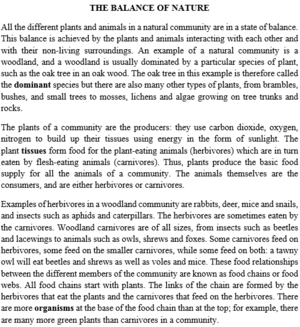Read the passage and mark the letter A, B, C or D to indicate the correct answer to each of the questions.
The forest from which Man takes his timber is the tallest and most impressive plant community on Earth. In terms of Man’s brief life, it appears permanent and unchanging, save for the season growth and fall of the leaves, but to the forester, it represents the climax of a long succession of events.
No wooded landscape we see today has been forest for all time. Plants have minimum requirements of temperature and moisture and, in ages past, virtually every part of Earth’s surface has, at some time, been either too dry or too cool for plants to survive.
However, as soon as climatic conditions change in favor of plant life, a fascinating sequence of changes, called a primary succession, occurs first to colonize the barren land and the lichen surviving on bare rock. Slowly, the acids produced by these organisms crack the rock’s surface, plants debris accumulate and mosses establish shallow root-holes. Ferns may allow and, with short grasses and shrubs, gradually form a covering of plant life. Roots broke even deeper into the developing soil and eventually large shrubs give way to the first trees. These grow rapidly, cutting off sunlight from the smaller plants, and soon establish complete domination - closing their ranks and forming a climax community which may endure for thousands of years. Yet even this community is not everlasting. Fire may destroy it outright and settlers may cut it down to gain land for pasture or cultivations. If the land is then abandoned, a secondary succession will take over, developing much faster on the more hospitable soil. Shrubs and trees are among the early invaders, their seeds carried by the wind, by birds and lodged in the coat of mammals.
For as long as it stands and strives, the forest is a vast machine storing energy and the many elements essential for life.
What conditions are needed for shrubs to become established?
A. More soil must accumulate.
B. The ground must be covered with grass.
C. Smaller plants must die now.
D. Ferns must take root.



Đáp án là A.
Dựa vào ý: Roots broke even deeper into the developing soil. These grow rapidly, cutting off sunlight from the smaller plants, and soon establish complete domination - closing their ranks and forming a climax community which may endure for thousands of years